| Home | Current show | Coming shows | Previous shows | Japanese pottery | Tea bowls | Sumi-e | Gallery tour | Wabi sabi | Order |
|
Japanese Tea Bowl Masterworks Exhibition 日本茶陶展 "Most eminent collection of Japanese tea bowls shown in America!" June 13 - August 6, 2003
Click here to see latest Tea Bowl Exhibition
|
|||
|
|
|||
|
The tea bowl used for the Japanese tea ceremony embodies unpretentious beauty, purity, dignity, and humility. Touching Stone Gallery is honored to host an exhibition of some of the best works by four top Japanese tea bowl masters: Shukai Kagami from Mino, Yuho Kaneshige from Bizen, Tadashi Nishihata from Tanba, and Kazu Yamada from Echizen. This is the first time these master ceramists have ever shown their works together in the same exhibition. The opening of the Japanese Tea Bowl Masterwork Exhibition coincides with the 50th anniversary of the New Mexico Museum of International Folk Art (MOIFA) in Santa Fe. Prior to the its inauguration in 1953, the museum hosted a series of lectures by the late Shoji Hamada, a ceramist and Living National Treasure of Japan, and the late British ceramist, Bernard Leach. To pay tribute to this historic connection, Touching Stone Gallery collaborates with MOIFA to host a 3-day celebration from June 13 to 15. The program includes the opening of the Japanese Tea Bowl Masterwork Exhibition at Touching Stone Gallery on June 13, followed by a tea ceremony on June 14 and a lecture on June 15. The tea ceremony and lecture will be presented at MOIFA by Dr. Shozo Sato, Professor Emeritus of University of Illinois and educator of Japanese art and culture.
|
|||
|
2003 Japanese Tea Bowl Masterworks Exhibition & Events
|
|||
 Dr. Sato performing a tea ceremony at the New Mexico Museum of International Folk Art in 2001 Photo © Touching Stone Images |
Shozo Sato 佐藤昌三 Dr. Shozo Sato, our special guest will perform a Japanese tea ceremony and present a lecture at the New Mexico Museum of International Folk Art (MOIFA). Dr. Sato should be no stranger to fans of Japanese arts in Santa Fe. In 2001, he performed a tea ceremony at MOIFA, and performed a Kabuki (Japanese opera) entitled "The Seven Happy Gods" at the Lensic Theatre in Santa Fe. Dr. Sato has devoted his long distinguished career to education of Japanese art and culture. He received a Ph.D. from Towson University and a D.F.A. from the University of Illinois. He was the founding director of Japan House, a Japanese cultural center at the University of Illinois. He is now Professor Emeritus of the University of Illinois. In addition to being a master of the Japanese tea ceremony, Dr. Sato is also a master of Ikebana (flower arrangement) and sumi-e (Oriental brush painting), and an author of books on Japanese art. He is also a director and producer of Kabuki. His Kabuki productions have received many international honors and awards, including the Critic’s Choice Award for Best Director at the Cairo International Experimental Theatre Festival, Joseph Jefferson Award (Chicago), awards from San Francisco Bay Area Theatre Critics Circle, Hollywood Drama Guild, Vita Award (South Africa), and Baltimore Sun Awards for directing and design. In recognition for his life-long efforts in promoting Japanese art and culture, the Japanese Minister of Foreign Affairs awarded Dr. Sato the Certificate of Commendation. |
||
|
|
|||
|
Exhibiting Artists (This show is sold out, please see our latest Tea Bowl Collection) |
|||
|
Shukai Kagami. Photo courtesy of Abe Publishing LTD., Tokyo, Japan |
Shukai Kagami 各務周海 If it takes a quiet mind to create good tea bowls, Shukai Kagami (1941-2009*) certainly has the proper training. Born in Mino as son of a Buddhist priest, Kagami received formal education in a Buddhist college in Tokyo. However, his intent was not to become a Buddhist priest, but to broaden his knowledge. His real interest was in making pottery. After graduation, Kagami sought training in a ceramic school in Gifu. Two years later, he took an apprenticeship with master potter Kobei Kato for three-and-a-half years. In 1969, he built his own kiln and began his independent career. Kagami designed his anagama kiln specifically for firing Shino and Yellow Seto (Ki-Seto) ceramics. Among the four well known ancient glazes (Shino, Oribe, Yellow Seto, Black Seto), Yellow Seto is the hardest to master. There are several salient features to look for in a good Yellow Seto bowl. ‘Abura-age-de’ (deep-fried tofu) refers to a thickly applied matte yellow glaze with a crinkled or semi-rough texture. This style was revered by tea masters and collectors in the Momoyama era. ‘Tanban’ is the term for green copper splashes on the yellow surface. These splashes should appear natural. ‘Koge’ refers to brown scorch marks that lend distinct characters to individual bowls. Many potters, including renowned master Tokuro Kato, have tried to reproduce the ‘Abura-age-de’ surface. However, no one has been able to reproduce this finish consistently until Shukai Kagami re-established the technique after experimentation for more than twenty years. According to Kagami, the key to a good Yellow Seto finish is in the firing, and firing with proper firewood is paramount. Ash directly affects the beauty of Yellow Seto. Currently, Kagami is probably the best ceramist who can produce the ‘Abura-age-de’ style. In addition to being a ceramist, Kagami is also a historian and an archaeologist. He has been excavating old kiln sites and collecting data on pottery shards and clay. His research earned him recognition and an award in 1979. * Shukai Kagami died in a tragic accident several years after this exhibition. As our respect for the artist, Touching Stone Gallery has stopped selling Mr. Kagami's work. |
||
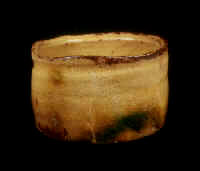 |
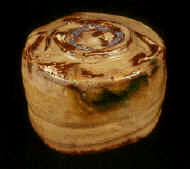 |
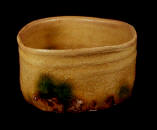 |
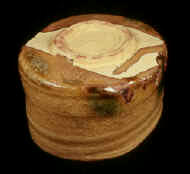 |
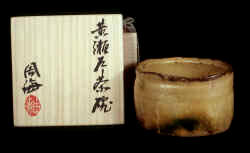 Shukai Kagami Ki-Seto Tea Bowl #1 (3 views) 3.5"H x 4.75" x 4.5" Sold |
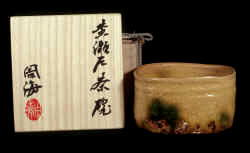 Shukai Kagami Ki-Seto Tea Bowl #2 (3 views) 3.25"H x 5" x 4.5" Sold |
||
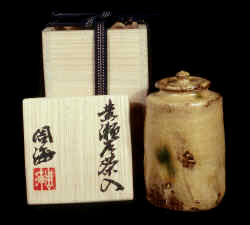 |
|||
|
Shukai Kagami Ki-Seto Tea Caddy 4"H x 2.25"D Not for sale |
|||
 Yuho Kaneshige. Photo courtesy of the artist. |
Yuho Kaneshige 金重有邦 Yuho Kaneshige was born in 1950 in Bizen into a family steeped in pottery tradition. His father, Sozan Kaneshige 金重 素山 (1909 - 1995), was a well-known master of "Cha-to" (tea ceremony ware). Yuho’s uncle, Toyo Kaneshige (1896 - 1967), was nominated as a living national treasure in 1956. Yuho Kaneshige studied sculpture in the Musashino Art College in Tokyo, then started making pottery with his father in Bizen. After his father’s death, he continued his family legacy creating pottery in his father’s studio. The tea bowl is Yuho Kaneshige’s passion. His work is strongly influenced by his unique philosophy. "Drinking tea is an ordinary act in everyday life. A good tea bowl allows tea to flow into your mouth naturally. Drinking from such a bowl makes you feel pleasant and natural, as if you are drinking water from a pond." Yuho Kaneshige believes that while the outer shape of the vessel is important, the inner space is even more so. When he throws on a wheel, he focuses on how to keep a balance between outer and inner movements. "Like a living creature, pottery has an outside body and an inner spirit. If I pay too much attention to the outer shape, no spirit will exist inside. Body and spirit, these two are complementary." Kaneshige suggested that a way to achieve such a balance is not to overload his work with his own individuality, but to let clay show its personality. By leaving out unnecessary techniques and grasping the essential, he brings out the essence of his work. As a result of his philosophy, Yuho Kaneshige’s tea bowls are completely devoid of pretentiousness. Each bowl exudes a distinct aura of quiet confidence and noble beauty. Kaneshige considers the tea bowl the most sensual of pottery. "Touching the rim of a tea bowl is like kissing. If you feel good, that is a good tea bowl!" |
||
 |
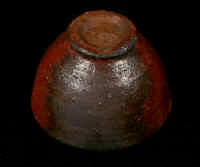 |
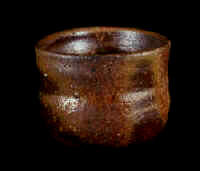 |
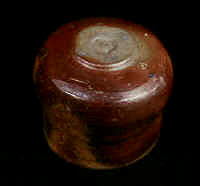 |
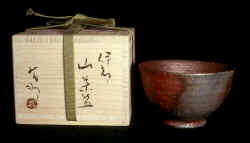 Yuho Kaneshige Bizen Tea Bowl #1 (3 views) 3"H x 5.25" x 5" Not available |
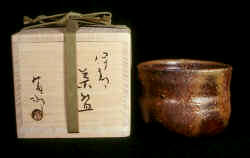 Yuho Kaneshige Boze Tea Bowl #2 (3 views) 3.5"H x 4.5" x 4" Not available |
||
 |
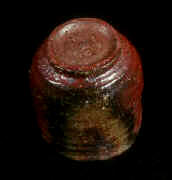 |
||
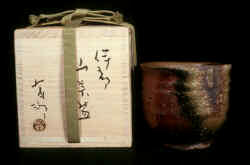 Yuho Kaneshige Bizen Tea Bowl #3 (3 views) 3.5"H x 4" x 3.75" Not available |
|||
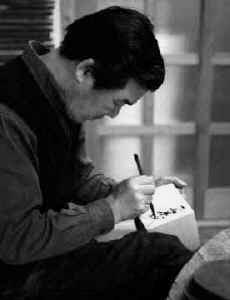 Tadashi Nishihata. Photo © Touching Stone Images. |
Tadashi Nishihata 西端正 Nestled in a beautiful valley along the Shitodani River that runs through towering mountains northwest of Kyoto is the picturesque village Tachikui, the historic center of Tanba pottery. The rich ferrous soil in this area has supported generations of farmers and artisans since the Kamakura period (1180 - 1230). This serene setting is home of some of the world’s most beautiful ceramics. Tadashi Nishihata (b. 1948) has lived in this village for his entire life. He overcame considerable challenges to establish himself a Cha-to (tea ceremony ware) artist, since historically Tanba is not a center of Cha-to. Perhaps for this reason, Nishihata has more freedom to develop his style. Consequently, his tea bowls are very distinctive. Nishihata draws inspirations from nature. Every winter, west wind blowing from the Sea of Japan brings snow to the mountains around Tanba, transforming the valley into a wonderland of frosted rocks and forests. When spring comes, black soil emerges from under the snow and the valley bursts into a rainbow of colors. Nishihata’s wood-fired tea bowls capture the changing landscapes. He uses different forms like ‘mentori’ (faceted), ‘ryo-sen’ (ridgeline) and ash glaze to transform his pieces into spectacular work of art that reflects the changing landscapes around his home. In addition to his tea bowls, Nishihata is widely recognized for his beautiful tea caddies. The current show includes examples of some of his best work. |
||
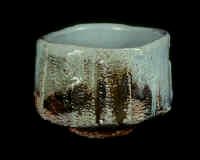 |
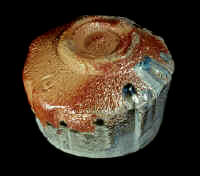 |
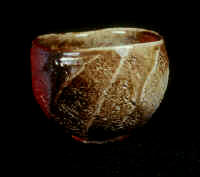 |
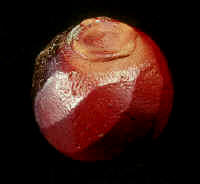 |
 Tadashi Nishihata Tea Bowl #1 (3 views) 3.75"H x 4.75" x 4.5" Sold |
 Tadashi Nishihata Tea Bowl #2 (3 views) 3.25"H x 4.25" x4.25" Sold |
||
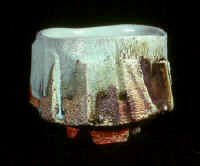 |
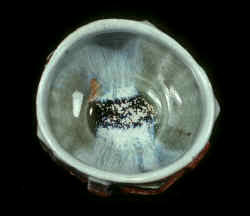 |
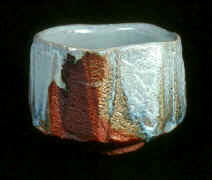 |
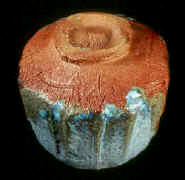 |
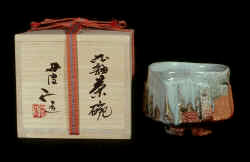 Tadashi Nishihata Tea Bowl #3 (3 views) 3.75"H x 5" x 5" Sold |
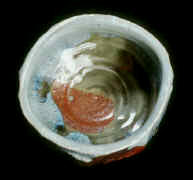 Tadashi Nishihata Tea Bowl #8 (3 views, box not shown) 4"H x 4.5" x4.5" Sold |
||
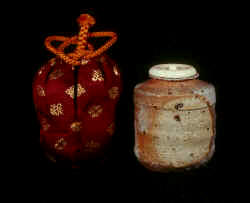 Tadashi Nishihata Tea Caddy #1 (2 views) 3.25"H x 2.25"D Sold |
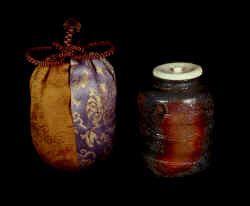 Tadashi Nishihata Tea Caddy #2 (2 views) 3.25"H x 2.25"D Sold |
||
 Kazu Yamada. Photo courtesy of the artist. |
Kazu Yamada 山田和 Born into a potter’s family in Tokoname, one of six oldest pottery centers in Japan, Kazu Yamada (b. 1954) developed an interest in pottery early. His career path was shaped by meeting with several particularly influential people. When he was 15, he worked with a group of potters who were building a large ceramic installation entitled "The Chair of Moon" for the Osaka Expo Exhibition Hall. Among the potters was internationally renowned ceramist Ryoji Koie 鯉江良二. For the first time, Yamada realized the enormous creative potential of pottery, and decided to become a potter. Yamada enrolled in Osaka Art College, and was greatly influenced by one of his teachers, famed ceramist Osamu Suzuki 鈴木治. During that time, he shunned the so-called traditional pottery and gravitated towards sculpture and architectural forms. Not until 1978 did he turned his attention towards tradition. In that year, ceramist Tokuro Kato 加藤唐九郎, a Japanese icon who started the renaissance of Momoyama pottery, came to see Yamada’s first solo show. Kato, who was in his 80s at the time, saw a great deal of talent and potential in the young Yamada, and invited Yamada for tea. They had tea in an old Shino tea bowl. Yamada was shocked by how strongly he responded to the old tea bowl. He realized that drawing a distinction between contemporary and tradition was superfluous; the tea bowl is pottery. Since that meeting, Kato became a mentor of Yamada, and the two continued a close friendship until Kato’s death in 1985. Yamada shares some of Kato’s philosophy about traditions. Both seek not to mimic old Momoyama pottery, but to create present day renditions built upon traditions. Their Shino, Oribe, Seto-Guro (black Seto) tea bowls are unique personal artistic expressions. Yamada is unquestionably one of the finest ceramists who choose to devote their lives to carry on this tradition. |
||
 |
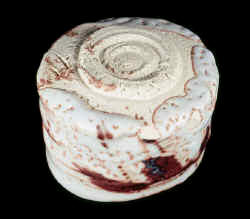 |
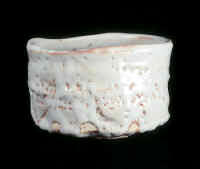 |
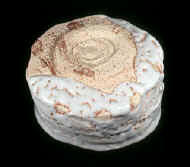 |
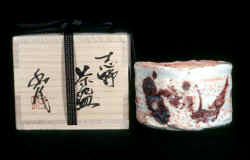 Kazu Yamada Shino Tea Bowl #1 (3 views) 3.5"H x 5" x 4.5" Not available |
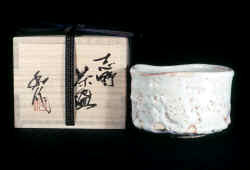 Kazu Yamada Shino Tea Bowl #2 (3 views) 3.75"H x 5.5" x 4.75" Sold |
||
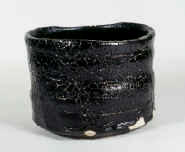 |
 |
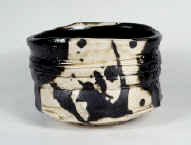 |
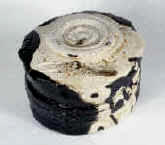 |
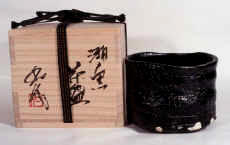 Kazu Yamada Black Seto Tea Bowl #3 (3 views) 3.5"H x 4.75" x 4.25" Sold |
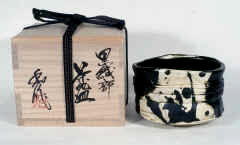 Kazu Yamada Black Oribe Tea Bowl #4 (3 views) 3.5"H x 5" x 4.25" Sold |
||
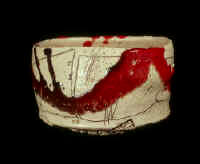 |
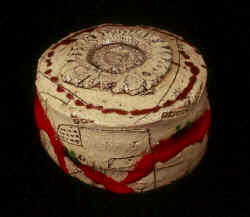 |
||
 Kazu Yamada Red Oribe Tea Bowl #5 (3 views) 3"H x 4.75" x 4.25" Sold |
|||
|
Old Kuro Oribe Tea Bowl This unusual Kuro (Black) Oribe tea bowl has an interesting history. It comes in an elaborately decorated silk pouch and a signed wooden box. The following writings appear inside the box lid: "Oribe Yaki, Sumiyoshi-to Go, Taisho, Soan". The writings suggest that this bowl was acquired sometime during the Taisho period (1912 - 1925) by Takahashi Soan, who named it "Sumiyoshi". Takahashi Soan (1861 - 1938) was a successful businessman and knowledgeable collector of tea ware. He authored the encyclopedic "Taisho Meiki Kan", a 10-volume reference on famous Japanese ceramists and their works. Additional writings on the exterior of the box identify the piece as "Oribe Kutsu", and name the maker as "Kinkuro, Oribe 10 Saku". The name Kinkuro is also carved into the bottom of the bowl. According to legends, renowned tea master Furuta Oribe (1543 - 1615) named ten outstanding Seto potters in recognition of their works. One of them was Kinkuro. However, little information about the potter or his lineage exists. There is one more interesting piece of history attached to this bowl. A wooden tag sewn onto a piece of cloth wrapping for the box bears the name "Magoshi Kasho". Magoshi, known as the King of Beer, was a magnate in Japanese beer industry in the Meiji era. Magoshi Kasho was also an avid collector of tea ware. This bowl appears to be among his prized possessions shortly before his death in 1918. |
|||
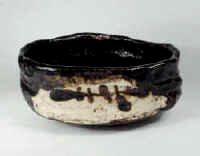 |
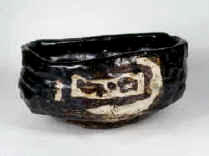 |
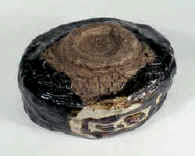 |
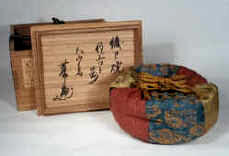 |
|
Old Kuro Oribe Tea Bowl named "Sumiyoshi" 2.25"H x 6" x 4.25" Not for sale |
|||
|
Classic Hagi Tea Bowls
The current show includes two classic tea bowls by 12th-generation Hagi potter Tahara Tobei (1925 - 1991). The bowl "Sogen" was a tribute to a historic Japanese tradition. According to this tradition, the emperor invites scholars to a poetry gathering at the Imperial Court of Japan in the New Year. A different theme is chosen every year for the New Year Poetry Party. The theme for the year 1963 was "Sogen" (Prairie). This tea bowl was likely made to celebrate the occasion. It is decorated with drawings of grass blades, and the name "Sogen" appears on the wooden box. The second tea bowl also by Tahara Tobei has a classic Wan Nari shape and beautiful crazing. |
|||
 |
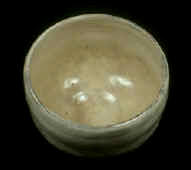 |
 |
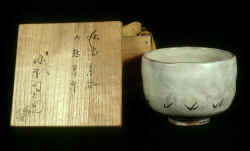 |
|
Tahara Tobei Hagi Tea Bowl #1, named "Sogen" (Prairie) 3.5"H x 4.5" x 4.25" Sold |
|||
 |
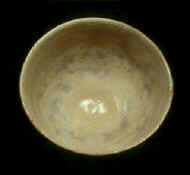 |
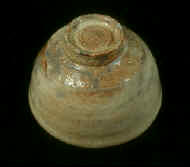 |
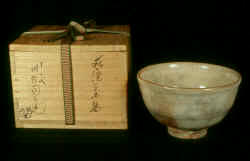 |
|
Tahara Tobei Hagi Tea Bowl #2 3.25"H x 5.25" x 5.25" Not for sale |
|||
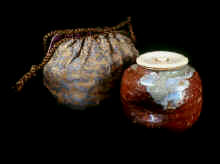 |
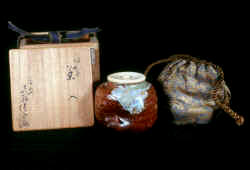 |
||
|
Morioka Kasho Iga Tea Caddy 2.5"H x 2.5"D
Sold This piece is dated to early 1900's. Current (3rd) generation of the Morioka family continues its ceramic tradition in Kyoto. |
|||